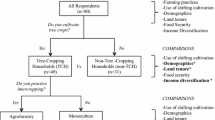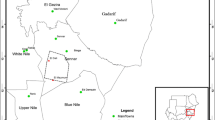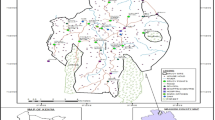Abstract
A questionnaire survey was conducted among 72 randomly selected households in Bukoba district, Tanzania from August to November 1991. The objective of the study was to identify the major constraints to increased productivity in homegardens and farmers response to these constraints. Declining of homegarden productivity seems to have been influenced by the gradual decline of soil fertility mainly as a result of decrease in cattle population, the serious outbreak of banana weevils, nematodes and later Panama disease, fragmentation of homegardens due to population growth and lack of cash. As a result, homegardens can no longer subsist farm families for the most part of the year. The actual decline in banana yield is 66% over the last 20 years. Incomes are too low to support modest investment to improve productivity in homegardens. Farmers' responses to these problems have been out-migration, a shift towards cultivation of root crops, planting of beer banana and decrease in homegarden management intensity. These responses however are likely to offer only short term and partial solutions.
Similar content being viewed by others
References
Acland JD (1971) East African Crops. Longman London
Coulson A (1982) Tanzania: A Political Economy Oxford University Press, London
Fernandes ECM, O'kting'ati A and Maghembe J (1984) The Chagga homegardens: a multistoried agroforestry cropping system on Mount Kilimanjaro (northern Tanzania) Agroforestry Systems 2: 73–86
Friedrich KH (1968) Coffee-banana holdings at Bukoba: the reasons for stagnation at a higher level. In: Ruthenberg H (ed) Smallholder Farming and Smallholder Development in Tanzania, Ten Case Studies. IFO Afrika-Stud, Munich, Germany
Hyden G (1969) Political Development in Rural Tanzania: A West Lake Study. East African Publishing House, Nairobi, Kenya
Kabwoto E (1976) Causes of decline in major crop production in Bukoba: banana, coffee and tea. Unpublished MSc thesis. University of Dar-es-Salaam Tanzania
Lele U (1984) Tanzania: Phoenix or Icarus? In: Harbuger AC (ed) Economic Growth: Case Studies of Developed and Developing Countries. ICS Press, San Francisco
Maruku (1980) Maruku Agricultural Research Institute: Annual Report 1979/80
Milne G (1938) Essays in applied pedology. Bukoba: high and low fertility on a laterised soil. East Afr Agric For J 4: 13–24
Mkamba I (1986) Maruku Agricultural Research Institute. Annual Reports 1981/86
Moberg JP (1972) Some soil fertility problems in the West Lake Region of Tanzania, including the effects of different forms of cultivation on the fertility of some ferralsols. East Afr Agric For J 38(1): 35–56
Moody AA (1970) A report on farm economic survey on tea smallholder, in Bukoba district. Economic Research Bureau. Paper 70.8 University of Dar-es-Salaam Tanzania
Oduol PA and Aluma JRW (1990) The Banana (Musa sppl.) — Coffeerobusta: traditional agroforestry system of Uganda. Agroforestry Systems. 11: 213–226
Royal Tropical Institute (1989) Diagnostic survey of Bukoba district. Working Paper No 3. Amsterdam, The Netherlands
Schuler U (1984) Rural Development Strategies and Land Use & Settlement Planning in Tanzania. Ardhi Institute, Dar-es-Salaam, Tanzania
Smith CD (1987) Smallholder Farming in Kagera Region, Tanzania: constraints to coffee production. Labour, Capital and Society 20(2): 207–216
Smith CD (1989) Did Colonialism Capture Peasantry? Case Study of Kagera Region, Tanzania. SIAS. Uppsala, Sweden
Soemarwoto O (1987) Homegardens: a traditional agroforestry system with a promising future. In: Steppler HA and Nair PKR (eds) Agroforestry: A Decade of Development. ICRAF, Nairobi, Kenya
Tibaijuka AK (1984) An analysis of smallholder banana-coffee farms in Kagera Region, Tanzania: causes of decline in productivity and strategies for revitalization. Published PhD thesis. Swedish University of Agricultural Sciences, Uppsala, Sweden
Valmayor RV (ed) (1990) Banana and Plantain R & D in Asia and the Pacific. International Network for the Improvement of Banana and Plantain. Montpellier, France
Author information
Authors and Affiliations
Rights and permissions
About this article
Cite this article
Rugalema, G.H., Johnsen, F.H. & Rugambisa, J. The homegarden agroforestry system of Bukoba district, North-Western Tanzania. 2. Constrainsts to farm productivity. Agroforest Syst 26, 205–214 (1994). https://doi.org/10.1007/BF00711211
Issue Date:
DOI: https://doi.org/10.1007/BF00711211




